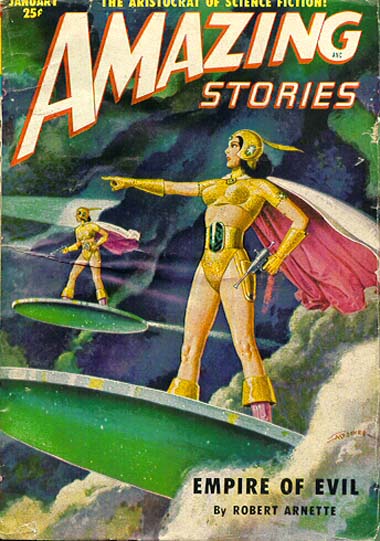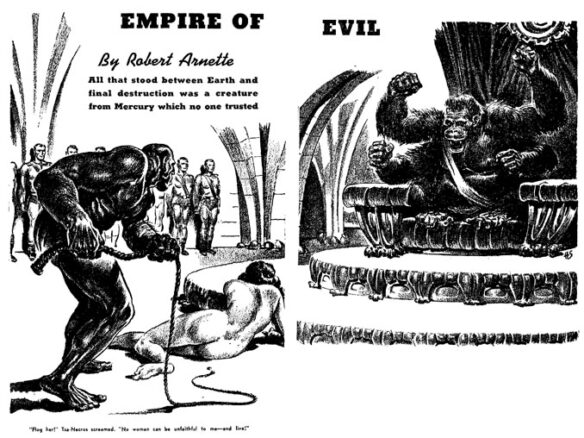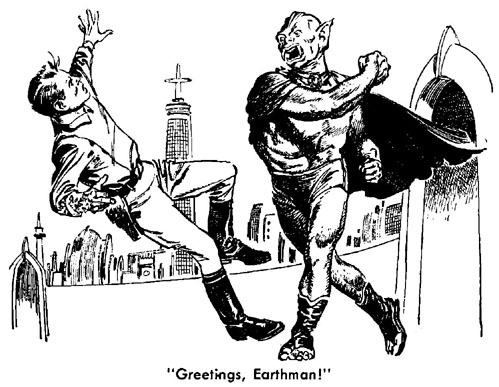
Guest Post by G.W. Thomas: Space opera in the 1950s found its home at Amazing Stories. For the nuts-and-bolts fan there was Astounding (not renamed Analog for another ten years). The literary reader had Fantasy & Science Fiction. The sophisticated fan had Galaxy. But if you wanted good old blasters and spaceships, after the death of Planet Stories in 1955 it was Amazing.
The Empire of Evil is a two-part space opera series by Robert Arnette that crossed that timeline. But these two stories pose questions. Arnette was a house name that belonged to the Ray A. Palmer Amazing Stories and was handed down to Howard Browne and later Paul W. Fairman when they edited the magazine.
The questions partly arise from the fact that these magazines were filled (during Browne and Fairman’s time anyway) by a stable of a dozen writers who produced 50,000 words a month for various magazines, which was purchased sight unseen. The editors didn’t bother to even read them so long as the quality didn’t slip too much. Writers like Milton Lesser, Henry Slesar, Robert Bloch, Randall Garrett, John Russell Fearn and others appeared every month as Alexander Blade, S. M. Tenneshaw, E. K. Jarvis and of course, Robert Arnette. Many of the stories’ creators are still unknown.
Robert Silverberg was one of these pseudonymous pulp-mill writers. In Other Spaces, Other Times, 2009, he remembers the creation of one story in particular:
In the 1950s magazine covers were printed well ahead of the interiors of the magazines, done in batches of, I think, four at a time. This was a matter of economics — using one large plate to print four covers at once was much cheaper than printing them one by one. But sometimes the practice created problems. For example, the April 1957 cover of Amazing Stories was printed in the fall of 1956 with a group of others, well ahead of its publication date, bearing this announcement above the name of the magazine: BEGINNING—COSMIC KILL—2-part serial of thundering impact.
“Cosmic Kill” was supposed to be a sequel to a short novel that Amazing had published six years before — “Empire of Evil,” by Robert Arnette. The readers had supposedly been clamoring for a follow-up to that great story all that time, and now, finally, it was going to be published.
According to Silverberg, the author of Empire of Evil was Paul W. Fairman, who had been promoted to editor after Browne left, and didn’t have time to pen the sequel. Unfortunately ISFDB lists Rog Phillips as author. I don’t know which of these men was “Robert Arnette” when the story appeared.
Link: Amazing Stories January 1951 issue at the Internet Archive.

This space opera novelette concerns a band of raiders who live on Venus in the city of Venusia. They pillage Earth and other planets ruthlessly, stealing their women. (Sleaze was a big part of selling SF in 1951.) The pirates are led by a scientific genius named Darrien. He can get away with his raiding because he has built a giant force-field shield that destroys invaders. Our heroes, there will be two, are set to find and destroy the generator of the shield.
The story opens with the first of two Earth agents, Ron Kratnick, going to his boss, Blake Wentworth, for the suicide mission of trying to infiltrate the reavers. Wentworth warns him he may have sit idly by when he sees some pirate molesting an Earth woman. But Kratnick’s cover must not be blown if he is to find the generator and destroy it.
Also undercover is Agent Tanton, thought dead by the Earth brass, who works his way towards the shield machinery by a circuitous route. He makes an offer to a beauty named Margot, who is love slave to an ugly underworld figure known as Tza-Necros. Tanton plans to get Margot next to Lars Valcan, the officer in charge of the generator in exchange for taking her to Earth, away from Tza-Necros’s reach.
Tanton is jailed but eventually allowed to escape. He steals a slaver’s booty as cover to get to his meet with Valcan but is attacked by Kratnick, who has come from Earth in a slaver ship. He had been followed by agents and starts drinking at a cafe. Now the story becomes about both of the men.
Tanton flees to the Undercity with both the new agent and the beautiful woman-prize, named Glory Evans. Tanton has an appointment with Valcan so he sends Kratnick and Evans on alone. They don’t end up finding Margot but in the hands of the Undercity people, and their leader, Caliban. Kratnick’s only hope is Tanton. Unfortunately, he went to his meeting with Valcan, brought him to meet Margot and got caught by Tza-Necros. Tanton is in the same cell as the two new lovers.
Things look pretty bleak for the Earth agents. Valcan is killed by Tza-Necros and Margot is thrown into the cell with the others. Without her beauty drugs, she becomes an old crone and dies. Tanton has a plan. He charges up Caliban with news that Darrien has found the Undercity and will soon kill everyone in it with a lethal gas. He lies, saying Tza-Necros knows this. Caliban leads the under-people in a mad rebellion. Tanton also tells him the shield generator is the really the gas machine. In this way, Caliban takes the agents to the building where the shield machinery is guarded.
The generator building is heavily guarded. The mob can’t penetrate their defences. The Earth trio sneak in. Guards come to arrest them. Ron and Glory escape out the roof on floating grav disks. Tanton stays behind to destroy the ray generator. He does this by throwing himself off twenty stories and sacrificing himself. The story ends with Ron quitting the secret service because he will never be as good as Tanton. He decides to become a farmer. Glory is overjoyed to become a farmer’s wife.
The Space Opera of the 1950s had some sophistication over the 1930s version but in many respects it hadn’t changed much at all. Arnette supposes humans living on all the planets of the Solar System. (Leigh Brackett was still doing the same thing at Planet Stories, around this time too, so it wasn’t only in Amazing.) This is not the cutting edge SF of John W. Campbell’s Astounding Science-Fiction. Ray A. Palmer had made Amazing Stories into an adventure SF Pulp back in 1939 and it still remained such, aimed at the juvenile market.
The story was illustrated by Henry Sharp, who would return six years later to illustrate the sequel. The cover for Empire of Evil was painted by Robert Gibson Jones, showing women flying on anti-grav disks. These devices are in the story but women are not soldiers, only booty, to the Venusians.
The second tale, “Cosmic Kill”, appeared in the digest-sized Amazing Stories. The collapse of 1955 cleared a rather crowded field. Plenty of SF magazines died along with the Pulps. Amazing was one of the long-standing survivors, but one of the least prestigious magazines still around. But Space Opera survived despite the haters.
The introduction to the sequel to “Empire of Evil” reads:
“Empire of Evil” (Jan 1951) was one of the most popular novelettes ever published in Amazing Stories. Mr. Arnette has done a sequel, featuring the same fabulous characters, and charged with the same suspense and furious action.
Silverberg recalls having to write a 20,000 word novella in two days. Randall Garrett, Bob’s partner in their little fiction factory, helped him out by introducing him to speed:
…I went out of my way to mimic the style of the original story, using all sorts of substitutes for “he said” that were never part of my own style —”he snapped,”“he wheezed,”“she wailed” and peppering the pages with adverbial modifiers — “he continued inexorably,” “he said appreciatively,” “he remarked casually.”The next day I took the whole 80-page shebang down to Paul Fairman’s office and it went straight to the printer. It was just in time for serialization in the April and May, 1957 issues of Amazing, my one and only appearance under the byline of Robert Arnette. And on the seventh day I rested, you betcha.
Link: Amazing Stories April 1957 issue at the Internet Archive.

Silverberg uses the same plot format as the first story. There will be two agents, a beauty belonging to a tyrant and a new virginal Earth girl/love interest. Silverberg picks up right after Fairman. Wentworth has a new agent in Lon Archman. Darrien escaped the bombing of Venusia and has fled to Mars. There he plots in secret. Lon’s assignment is to find and kill the evil genius. He will have to be careful of the simulacra Darrien uses as decoys. The assignment is illegal and Lon can expect no official help from Earth.
Hendrin is also an agent but not of Earth. He has been sent by the ruler of Mercury to discover all of Darrien’s secrets, the space mines, the robot doubles, etc. then to kill the evil scientist. He ingratiates himself by buying an Earth woman named Elissa Hall, stolen from an Earth outpost. Hendrin plans to sell her to Darrien and work his way into the upper escalations.
Lon Archman runs into him in the bar where he buys the girl. The agent follows him to the office of Dorvis Graal, the Viceroy of Canalopis, Darrien’s capitol on Mars. Graal allows the Mercurian to take his prize to the master. Darrien is smitten with the girl, buying her for two hundred credas and a captaincy. Meryola, Darrien’s mistress, is not pleased. Meryola is beautiful but aging, despite the youth drugs. She will not put up with any rival. Hendrin double-deals with her, saying he will steal her away to the dungeons.
Archman plays his own desperate game with Dorvis Graal and is imprisoned. He is placed in the same cell as Elissa. With her help, he escapes while she remains imprisoned. Running, he encounters Hendrin who has just had a disastrous moment with Meryola and Darrien. Visiting the mistress, the Mercurian is caught by Darrien. But the scientist isn’t jealous. He just wants his play-thing back. He tells Hendrin if he doesn’t produce the girl, he will die. Meryola tells him the opposite, if he doesn’t kill her, he dies.
The two agents team up (as Tanton and Ron did before) and rescue Elissa. Together they put Hendrin’s plan into action. He and Elissa will go to Darrien and tell him that Meryola planned to assassinate him. Meanwhile Lon goes to the mistress and tells her that Darrien plans to kill her. When Martians come to take her, she falls in with Archman. She reveals that the real Darrien is hiding in a secret room only she knows. She takes the Earthman to the real Darrien.

But Lon can’t shoot him dead because he has Elissa as a shield. Meryola is all for shooting them both but Archman won’t. Hendrin and one of the Darrien robots show up and in a scene worthy of Hamlet, Hendrin, Meryola and the imposter robot all die. Lon is left to shoot Darrien dead and win Elissa’s love.
The plot seems very familiar with Hendrin in place of Tanton, Meryola in place of Margot, Darrien for Tza-Necros, Lon for Ron, etc. Silverberg livens it up by having the objective to kill Darrien rather than destroy the shield generator.
Silverberg passes judgment on his old story:
The funny thing is that “Cosmic Kill” isn’t really so bad. I had to read it for the first time in 48 years for Tales from the Pulp Era, and I was impressed with the way it zips swiftly along from one dire situation to another without pausing for breath, exactly as its author did back there in December 1956. It is the one and only example of Silverberg writing a story on speed.
My judgment is a little less lenient. Silverberg cannibalizes the first story heavily, giving a largely repeat performance. He hasn’t added much except a finale for Darrien, which Fairman hadn’t provided in Empire of Evil.
As a fan of Space Opera, I quite enjoyed both tales for its different races, each distinct and largely evil. The action is simple but effective. (Like when Hendrin blows the head off a Plutonian by shoving a zam-gun into his large, fishy mouth.) This is not Hugo-winning stuff and it never was meant to be. The spirit of the Clayton Astounding to Buck Rogers lives here. Today it lies in Star Wars but back in the 1950s it could only be found in Amazing Stories.
BIO: G. W. Thomas has appeared in over 400 different magazines, books, podcasts and webzines including Writer’s Digest, The Armchair Detective and Pseudopod. His latest book is a collection of Space Westerns called Whispers of Ice and Sand. His blog is gwthomas.org.
Discover more from File 770
Subscribe to get the latest posts to your email.

“The sophisticated fan had Galaxy.” And what about If (or Worlds of If – title varied, I think)?
What about “Quest of the Golden Ape” by Darius John Granger (published in Amazing as a three-part serial in 1957)
“An ape, a boar, a stallion
a prison without bars
A raging beast, a virgin feast
a land beyond the stars”
If we’re talking about real high quality literature … 🙂
Flash fiction: the early days.
There were, of course, other outlets for Space Opera — one of the most obvious being Science Fiction Adventures (and Silverberg was a regular contributor there as well.) One might also mention Bill Hamling’s companion to Imagination, Imaginative Tales.
But the detailed look at “Cosmic Kill” is pretty fun, and thanks for that!
Pingback: AMAZING NEWS FROM FANDOM: June 4, 2023 - Amazing Stories